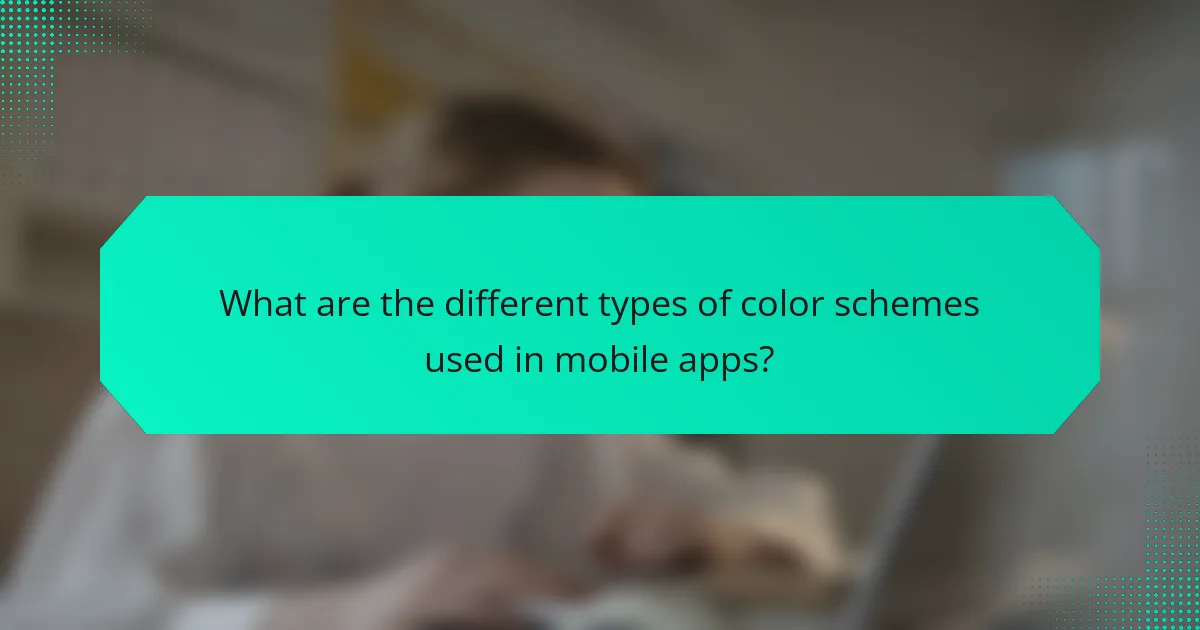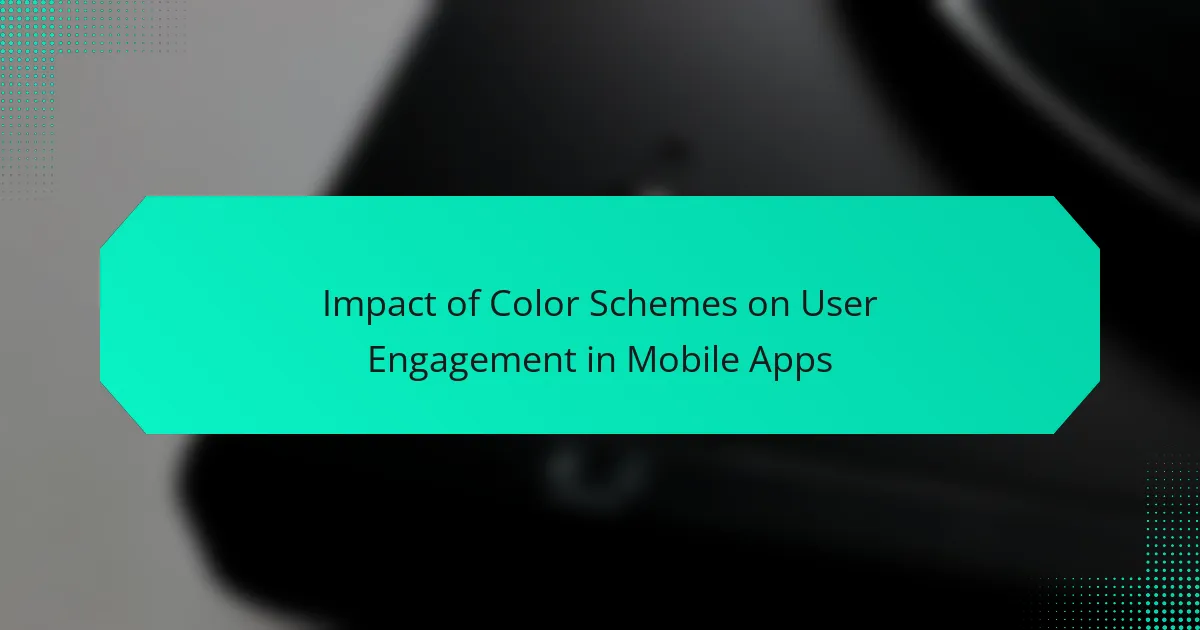Color schemes play a crucial role in user engagement within mobile applications, significantly influencing users’ emotions and perceptions. A well-selected color palette enhances both usability and aesthetic appeal, impacting first impressions and purchasing decisions. Various types of color schemes, including monochromatic, analogous, complementary, triadic, and tetradic, each offer unique visual experiences that can guide user behavior and improve navigation. Developers can assess the effectiveness of these color schemes through A/B testing, which measures engagement metrics to inform data-driven decisions. Understanding the impact of color on user retention and satisfaction is essential for creating effective mobile app designs.

What is the impact of color schemes on user engagement in mobile apps?
Color schemes significantly impact user engagement in mobile apps. They influence users’ emotions and perceptions. A well-chosen color palette can enhance usability and aesthetic appeal. Research indicates that color affects first impressions within 90 seconds. For instance, studies show that 85% of consumers make purchasing decisions based on color. Additionally, colors can guide user behavior and navigation within an app. For example, contrasting colors can improve readability and highlight important features. In summary, effective color schemes can lead to higher user retention and satisfaction.
How do color schemes influence user behavior in mobile applications?
Color schemes significantly influence user behavior in mobile applications by affecting emotions and decision-making. Specific colors can evoke feelings such as trust, excitement, or calmness. For instance, blue often conveys trustworthiness, making it popular in financial apps. Conversely, red can stimulate urgency, prompting quicker actions like purchases. Research indicates that users are more likely to engage with apps that use appealing color schemes. A study by K. H. W. Wong and M. K. K. Cheng found that color contrasts enhance visibility and usability, leading to better user experiences. Thus, selecting the right color scheme is crucial for improving user engagement and satisfaction in mobile applications.
What psychological effects do different colors have on users?
Different colors have distinct psychological effects on users. Red often evokes feelings of excitement and urgency. It can increase heart rates and encourage quick decisions. Blue, on the other hand, promotes calmness and trust. Studies show that blue environments can enhance focus and productivity. Yellow is associated with happiness and energy but can also cause visual fatigue. Green represents nature and balance, often reducing anxiety. Purple is linked to creativity and luxury, appealing to imaginative users. Each color’s impact can vary based on cultural context and personal experiences. Understanding these effects can enhance user engagement in mobile apps.
How can color schemes enhance or hinder usability?
Color schemes can significantly enhance or hinder usability in mobile apps. Effective color schemes improve readability and navigation. High contrast between text and background aids in visibility. Colors can also convey meaning, guiding user actions intuitively. For example, red often indicates errors, while green signals success. Conversely, poor color choices can create confusion. Low contrast can lead to eye strain and difficulty in reading. Colors that clash may distract users from important content. Research by the Nielsen Norman Group shows that color affects user experience and task completion rates. Thus, thoughtful color selection is crucial for optimal usability.
Why are color schemes important for mobile app design?
Color schemes are crucial for mobile app design because they influence user perception and engagement. Effective color choices can enhance usability by improving readability and navigation. For instance, contrasting colors can highlight important features and call-to-action buttons. Research shows that color affects emotions; warm colors can evoke excitement, while cool colors promote calmness. A study by the Institute for Color Research found that color increases brand recognition by up to 80%. Additionally, consistent color schemes can strengthen brand identity. Overall, well-designed color schemes contribute significantly to user experience and retention.
What role do color schemes play in branding and identity?
Color schemes play a crucial role in branding and identity by influencing consumer perception and emotional response. They create visual consistency across marketing materials, enhancing brand recognition. Research shows that color increases brand recognition by up to 80%. Different colors evoke specific emotions; for example, blue conveys trust and professionalism, while red can evoke excitement and urgency. Companies often choose color schemes that align with their brand values and target audience. Effective use of color can differentiate a brand in a crowded market. Brands like Coca-Cola and McDonald’s utilize distinctive color schemes to reinforce their identities. Overall, color schemes are integral to establishing a strong brand identity and fostering consumer loyalty.
How do color schemes affect user retention and satisfaction?
Color schemes significantly impact user retention and satisfaction. Users often respond positively to aesthetically pleasing color combinations. Research shows that 90% of snap judgments about products are based on color alone. Effective color schemes can enhance brand recognition by up to 80%. Colors influence emotions and behaviors, with warm colors often creating a sense of urgency. Conversely, cool colors can promote calm and trust. A well-designed color palette can lead to a 30% increase in user engagement. This ultimately translates to higher retention rates as users feel more connected to the app.

What are the different types of color schemes used in mobile apps?
The different types of color schemes used in mobile apps include monochromatic, analogous, complementary, triadic, and tetradic schemes. Monochromatic color schemes utilize variations in lightness and saturation of a single hue. This creates a harmonious look and is easy on the eyes. Analogous color schemes consist of colors that are next to each other on the color wheel. They provide a serene and comfortable design. Complementary color schemes use colors from opposite sides of the color wheel. This contrast can create vibrant and energetic visuals. Triadic color schemes involve three colors that are evenly spaced around the color wheel. This scheme is balanced and offers a dynamic look. Tetradic color schemes use four colors, forming two complementary pairs. This allows for rich color diversity while maintaining harmony. Each of these schemes influences user engagement and visual appeal in mobile apps.
How do complementary and analogous color schemes differ in application?
Complementary color schemes use colors opposite each other on the color wheel. They create high contrast and vibrant visuals. This application is effective for grabbing attention and highlighting important elements. For instance, a red button on a green background stands out clearly.
Analogous color schemes consist of colors next to each other on the color wheel. They create harmony and a cohesive look. This application is ideal for creating a calming and unified interface. For example, using blue, blue-green, and green can evoke a serene atmosphere.
In summary, complementary schemes enhance visibility and focus, while analogous schemes promote tranquility and flow.
What are the advantages of using a monochromatic color scheme?
A monochromatic color scheme offers several advantages in design. It creates a cohesive and harmonious look. This visual unity can enhance user experience. Monochromatic schemes simplify color selection, reducing design complexity. They also allow for greater emphasis on content without color distractions. Research shows that such schemes can improve readability and focus. Additionally, they can evoke specific moods or feelings effectively. For instance, blue hues can convey trust and calmness. Overall, a monochromatic color scheme can significantly enhance user engagement in mobile apps.
How can triadic color schemes create visual interest?
Triadic color schemes create visual interest by using three colors that are evenly spaced on the color wheel. This arrangement provides a balanced yet dynamic contrast. The contrast between the colors enhances visual appeal. It draws the viewer’s attention effectively. Studies show that well-chosen triadic schemes can improve user engagement. For instance, a study by the Interaction Design Foundation highlights that color contrast can influence user interaction positively. This proves that triadic color schemes are effective in enhancing visual interest in mobile app design.
What factors should designers consider when choosing a color scheme?
Designers should consider psychological effects, brand identity, color harmony, and accessibility when choosing a color scheme. Psychological effects influence user emotions and behaviors. For instance, blue often conveys trust, while red can evoke urgency. Brand identity requires colors that reflect the brand’s values and mission. Color harmony ensures that the selected colors work well together, creating a visually appealing aesthetic. Accessibility involves ensuring that color choices are distinguishable for users with visual impairments. According to the Web Content Accessibility Guidelines (WCAG), proper contrast ratios enhance usability for all users.
How does target audience influence color scheme selection?
Target audience significantly influences color scheme selection. Different demographics respond uniquely to colors. For example, younger audiences may prefer vibrant, energetic colors. In contrast, older demographics often favor muted, classic tones. Cultural backgrounds also impact color perception. Certain colors evoke specific emotions in different cultures. Research indicates that color can affect user behavior. A study by Kuo and Sajjad (2019) found that color schemes aligned with audience preferences enhance engagement. Thus, understanding the target audience is crucial for effective color scheme selection.
What accessibility considerations should be made in color choices?
Accessibility considerations in color choices include ensuring sufficient contrast between text and background colors. This helps users with visual impairments read content easily. The Web Content Accessibility Guidelines (WCAG) recommend a contrast ratio of at least 4.5:1 for normal text and 3:1 for large text. Additionally, avoid using color as the only means of conveying information. This supports colorblind users who may not differentiate certain hues. Using patterns or labels alongside colors enhances understanding. Testing color choices with accessibility tools can identify potential issues. Research shows that inclusive design improves user engagement across diverse audiences.

How can developers measure the effectiveness of color schemes on user engagement?
Developers can measure the effectiveness of color schemes on user engagement through A/B testing. A/B testing involves creating two versions of an app with different color schemes. Users are randomly assigned to each version. Engagement metrics such as click-through rates, time spent on the app, and conversion rates are then analyzed. For instance, a study by Google found that contrasting colors can increase user engagement by up to 20%. Analytics tools can track user interactions and provide data on which color scheme performs better. This method allows developers to make data-driven decisions regarding color choices.
What metrics can be used to assess user engagement related to color schemes?
Metrics used to assess user engagement related to color schemes include click-through rates, time spent on page, and bounce rates. Click-through rates indicate how often users interact with elements influenced by color. Time spent on page reflects user interest and engagement levels. Bounce rates measure the percentage of users who leave after viewing only one page, indicating potential issues with color appeal. Additionally, user feedback through surveys can provide qualitative insights on color preferences. Heatmaps can visually represent user interactions with different color elements. A/B testing different color schemes can quantitatively assess their impact on engagement. These metrics collectively provide a comprehensive view of how color schemes affect user engagement in mobile apps.
How can A/B testing be utilized to evaluate color scheme impact?
A/B testing can be utilized to evaluate color scheme impact by comparing user engagement metrics between two different color schemes. In this method, one group of users interacts with the app featuring the original color scheme, while another group experiences a modified version. Key metrics such as click-through rates, conversion rates, and time spent on the app are measured for both groups. This approach allows for direct comparison of user behavior in response to the color variations. Research indicates that color can influence user emotions and decision-making, significantly impacting engagement. A study by Satyendra Singh in the Journal of Management Science found that color affects purchasing decisions in 85% of consumers. Thus, A/B testing provides empirical data on how color schemes influence user engagement in mobile apps.
What role do user feedback and analytics play in refining color schemes?
User feedback and analytics are crucial in refining color schemes for mobile apps. They provide direct insights into user preferences and behaviors. Analytics track user interactions with different color schemes. This data reveals which colors enhance engagement and retention. User feedback offers qualitative insights into emotional responses to colors. Surveys and usability tests gather opinions on color effectiveness. Together, these methods inform design decisions. Adjustments based on this data can lead to improved user satisfaction. Studies show that optimized color schemes can increase conversion rates by up to 24%.
What best practices should be followed for optimizing color schemes in mobile apps?
Use high contrast for readability in mobile app color schemes. High contrast improves text visibility and user interaction. Choose colors that align with your brand identity. Consistent color usage reinforces brand recognition. Limit your color palette to three to five colors. A simplified palette reduces cognitive load for users. Test color schemes for accessibility compliance. Tools like WCAG guidelines ensure inclusivity. Use color psychology to evoke desired emotions. Colors can influence user behavior and engagement. Regularly gather user feedback on color preferences. User input helps refine and optimize the color experience.
How can consistency in color usage improve user experience?
Consistency in color usage enhances user experience by creating a cohesive visual identity. This allows users to quickly recognize and navigate an app. Familiar color schemes reduce cognitive load, making interfaces easier to understand. Research shows that consistent color usage can increase user retention by up to 23%. Additionally, it fosters a sense of trust and professionalism. Users are more likely to engage with apps that present a unified look. This consistency also aids in brand recognition, reinforcing user loyalty. Thus, effective color consistency directly contributes to improved user engagement and satisfaction.
What tips can enhance the effectiveness of color schemes in user interfaces?
To enhance the effectiveness of color schemes in user interfaces, prioritize color contrast for readability. High contrast between text and background improves legibility. Utilize a limited color palette to create a cohesive look. This approach helps users navigate the interface intuitively. Consider color psychology to evoke specific emotions. For instance, blue can instill trust, while red may create urgency. Test color combinations with real users to gather feedback. User testing ensures that color choices resonate with the target audience. Finally, maintain consistency across all screens. Consistent color usage reinforces brand identity and user familiarity.
The main entity of this article is the impact of color schemes on user engagement in mobile apps. The article explores how color schemes influence user emotions, behaviors, and perceptions, highlighting their role in enhancing usability and aesthetic appeal. Key topics include the psychological effects of different colors, the importance of color schemes in branding, and how effective color choices can lead to increased user retention and satisfaction. Additionally, the article discusses various color schemes used in mobile app design and best practices for optimizing color usage to improve user experience.


